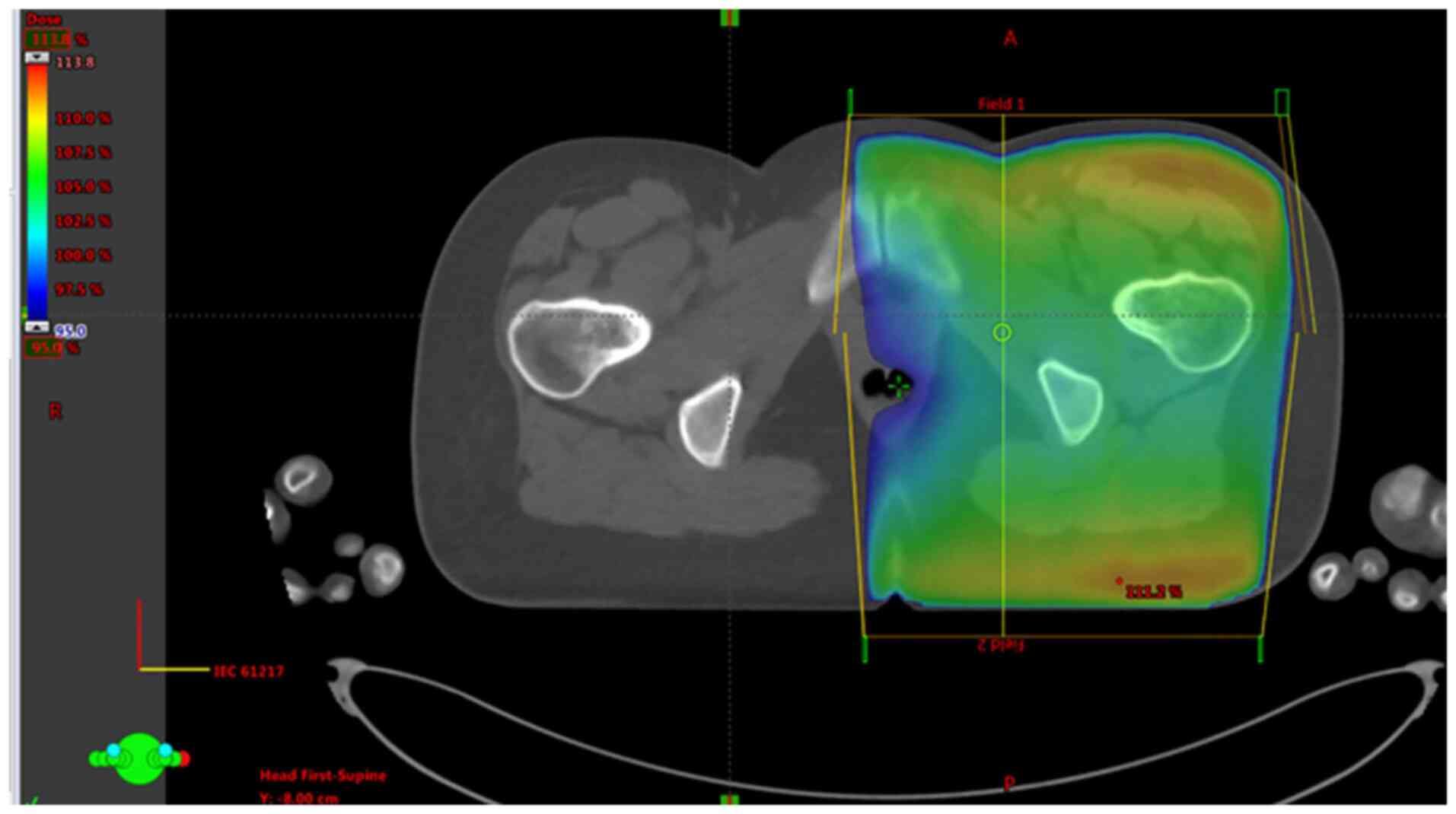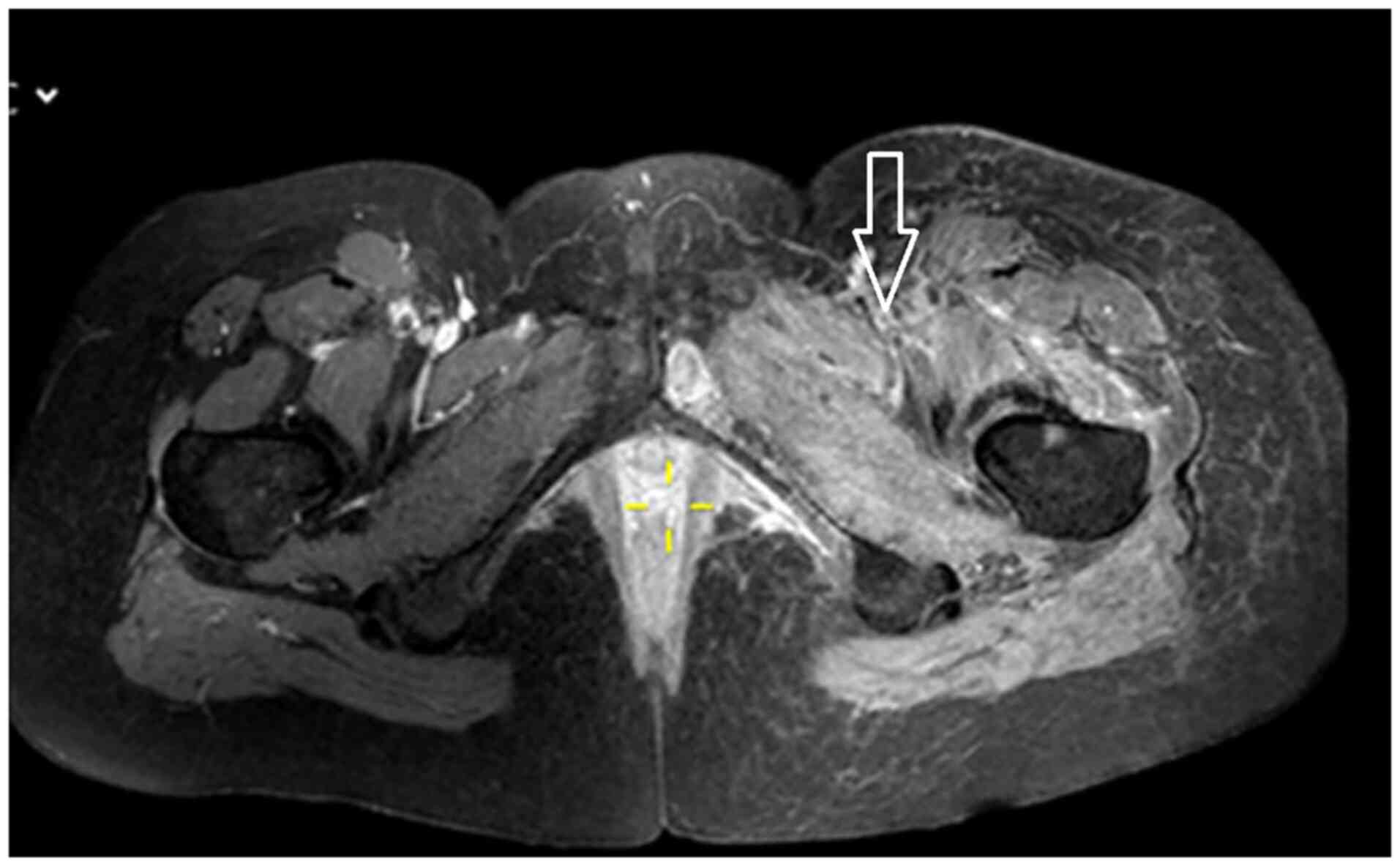Introduction
Radiation recall (RR) is a rare phenomenon that
involves an inflammatory tissue reaction on the previously
irradiated site upon systemic administration of an initiating agent
within days (>7 days), months or years (1). Since it was first described in 1959,
dermatitis has been the most frequently reported and clinically
observed RR reaction (2). After
skin, muscles, mucous membranes in the upper respiratory tract,
lung, gastrointestinal tract and central nervous system are other
recognised sites of this inflammatory reaction (3). RR myositis (RRM) is the second most
commonly reported RR toxicity after dermatitis in the literature. A
literature search using PubMed was performed, and ‘radiation recall
myositis’ was used as a search term to review previous cases
related to docetaxel and other chemotherapy agents. RRM has been
associated with various chemotherapies, and gemcitabine was
responsible for ~2/3 of these cases; however, only 1 case of RRM
was found following docetaxel and carboplatin combination
chemotherapy (4).
The present study describes a patient with RRM and
dermatitis, and constitutes the second reported RRM case after
docetaxel chemotherapy in the literature. The difference between
the present case and the previously reported case is that the
present study reported on RRM after only docetaxel treatment,
whereas the previous case reported on RRM after treatment with a
combination of carboplatin and docetaxel. The present case
highlighted an important but rare phenomenon in a patient with
breast cancer receiving docetaxel chemotherapy.
Case report
A 26-year-old woman who was diagnosed with breast
cancer was admitted to the Kocaeli University Medical Oncology
Clinic (Kocaeli, Turkey) in March 2020, after undergoing a right
breast lumpectomy and axillary lymph node dissection. The patient
was diagnosed with multifocal invasive breast carcinoma and
axillary lymph node metastasis, and the tumor was positive for
estrogen and progesterone receptors, negative for human epidermal
growth receptor 2 and 80% positive for Ki-67. A post-operative
positron emission tomography (PET) scan carried out in March 2020
demonstrated multiple hypermetabolic lymph nodes in the
mediastinum, metastasis in the liver and multiple bone metastasis.
Her initial treatment involved an aromatase inhibitor combined with
a luteinizing hormone-releasing hormone agonist and zoledronic
acid. The patient was referred to the Kocaeli University
Radiotherapy Clinic (Kocaeli, Turkey) in April 2020 for palliative
treatment of the bone metastases, which caused severe pain.
The left pubis and left femur head and neck were
treated with palliative 3D-conformal radiotherapy at a dose of 20
Gy in 5 daily fractions (Fig. 1),
while the lumbar spine (from L2 to S1) was treated with a dose of
30 Gy sequentially. The treatment ended on 12th May 2020. After 2
months, in July 2020, a PET/computed tomography scan revealed new
lesions, and the medical oncologist of the patient initiated
systemic treatment with docetaxel (75 mg/m2 every 3
weeks) as a single agent, while a new bone lesion on T8 was treated
with sterotactic body radiotherapy (SBRT) at a dose of 24 Gy in 3
daily fractions. After 3 months of palliative radiotherapy and a
second dose of chemotherapy, the patient described a gradually
increasing pain in her left femur with erythema on her skin in the
lumbar and gluteal region, in addition to swelling on the gluteal
muscles. Magnetic resonance imaging (MRI) of the pelvis revealed
asymmetrical swelling of her left proximal thigh with signal
enhancement on T2 and increased contrast uptake on T1 (Fig. 2) on muscles. In the differential
diagnosis, autoimmune and inflammatory etiologies (polymyositis,
dermatomyositis and vasculitis) were considered, and rheumatoid
workup with serologies, including anti-nuclear and anti-double
stranded DNA antibodies against nuclear antigens (Euroimmun) was
performed. The results were within the normal limits (Table I). In physical examination, the
muscle strength was normal.
 | Table ILaboratory findings of the
patient. |
Table I
Laboratory findings of the
patient.
| Laboratory test | Variable, value
(normal range) |
|---|
| Anti-nuclear
antibodies | Negative |
| Anti-double stranded
DNA antibodies | Negative |
| Serum creatine
kinase, U/l | 47 (0-145) |
| RF, IU/ml | 1.99 (<14.0) |
| C3, g/l | 1.42 (0.90-1.80) |
| C4, g/l | 0.40 (0.10-0.40) |
The diagnosis was myositis and dermatitis associated
with an RR reaction induced by docetaxel based on the association
with radiation treatment volume and the radiographic evidence of
myositis (Figs. 1 and 2). The time period from the final
treatment with radiation to the development of myositis was 3
months. The patient was treated with an oral non-steroidal
analgesic (etodolac, 400 mg b.i.d), and chemotherapy (docetaxel 75
mg/m2 every 3 weeks) continued. The patient's pain
decreased gradually in 1 month; however, after nine cycles of
chemotherapy, extensive liver metastasis appeared and the patient
died.
Discussion
Docetaxel is an important agent used to treat breast
cancer in all settings (neoadjuvant, adjuvant and metastatic). The
most common treatment-related side effects are infusion reactions,
febrile neutropenia, fatigue, fluid retention and peripheral
neuropathy (5). It can also lead
to side effects in muscle, such as myalgia-arthralgia syndrome,
which is oftenly associated with moderate or severe generalized
musculoskeletal pain during the first hours or days after taxane
administration (6). Myositis by
itself is an uncommon side effect, and has been reported only in 5
cases (7).
Docetaxel-induced RR reactions have been reported as
dermatitis and mucositis since 1994(8). In 2006, Mizumoto et al
(9) documented the incidence of a
RR reaction following treatment with docetaxel as 1.8% in their
series. Chemotherapy-related RRM cases have been reported in the
literature to be commonly associated to gemcitabine chemotherapy
(10,11). To the best of our knowledge, the
present case together with a previous case are the only 2 RRM cases
upon docetaxel chemotherapy described in the literature. In the
case reported by Chao et al (4) a 55-year-old man with metastatic
prostate cancer was treated with palliative RT for his right hip at
a dose of 30 Gy in 10 daily fractions by anteroposterior and
posteroanterior fields. Carboplatin and docetaxel chemotherapy was
initiated 2 months after the completion of RT. After 6 months of
RT, recurrent and persistent pain, and swelling complaints of the
patient emerged in the right hip and thigh, which were resolved
temporarily following pretreatment with dexamethasone. His MRI
revealed asymmetrical swelling of the right thigh musculature,
which was irradiated.
In the present case, docetaxel was the single agent
and the triggering cause of RRM, and both dermatitis and myositis
were observed. Naranjo et al (12) assessed the correlation between
adverse effects and docetaxel with a score of 5, and the
correlation was defined as ‘probable’.
The pathophysiology of RRM is unknown, and the
current hypothesis suggests that cytotoxic treatment following
radiotherapy causes memory reaction in the remaining surviving
cells within the previously irradiated field. The other commonly
suggested hypotheses include depletion of stem cells, changes in
the local vasculature and drug-induced hypersensitivity reactions
(13). There are suggestions about
the implication of radiation dose threshold and fraction size in
recall reactions, but there is no clear evidence to support such
hypotheses. In addition, they can occur at any time varying from
days to years after completing radiotherapy.
In the present case, RRM symptoms started 3 months
after radiotherapy and 6 weeks after docetaxel chemotherapy.
Myositis, except dermatitis, was not observed in the lumbar region
although this area was treated with a higher dose than the one used
for the hip. The patient did not complain about any pain in the T8
region, which was treated with SBRT.
In conclusion, pain, swelling, edema and enhanced
contrast in the underlying musculature of previously irradiated
areas following treatment with a chemotherapy agent are
characteristics of RRM, and should be considered in the
differential diagnosis of localized pain. Cessation of the
treatment is not needed always, and it depends on the severity of
the reaction. Since it usually resolves after 1-2 weeks of
administration of corticosteroids and nonsteroidal
anti-inflammatory drugs, patients can continue treatment without
rechallenge.
Despite the most common cause of RRM is gemcitabine,
docetaxel should be also acknowledged as a cause of RRM.
Acknowledgements
Not applicable.
Funding
Funding: No funding was received.
Availability of data and materials
The datasets used and/or analyzed during the current
study are available from the corresponding author on reasonable
request.
Authors' contributions
AÜK collected patient data and designed the study.
BA participated in the analysis and interpretation of data. AÜK and
BA both contributed to manuscript drafting, writing and final
correction of the manuscript. All authors read and approved the
final version of the manuscript, and confirm the authencity of all
the raw data.
Ethics approval and consent to
participate
Not applicable.
Patient consent for publication
The patient provided written informed consent for
the publication of the present article, including any associated
data and accompanying images.
Competing interests
The authors declare that they have no competing
interests.
References
|
1
|
Friedlander PA, Bansal R, Schwartz L,
Wagman R, Posner J and Kemeny N: Gemcitabine-related radiation
recall preferentially involves internal tissue and organs. Cancer.
100:1793–1799. 2004.PubMed/NCBI View Article : Google Scholar
|
|
2
|
D'Angio GJ, Farber S and Maddock CL:
Potentiation of X-ray effects by actinomycin D. Radiology.
73:175–177. 1959.PubMed/NCBI View
Article : Google Scholar
|
|
3
|
Azria D, Magné N, Zouhair A, Castadot P,
Culine S, Ychou M, Stupp R, Van Houtte P, Dubois JB and Ozsahin M:
Radiation recall: A well-recognized but neglected phenomenon.
Cancer Treat Rev. 31:555–570. 2005.PubMed/NCBI View Article : Google Scholar
|
|
4
|
Chao HH, Feld EK, Narayan V, Sebro R and
Jones JA: Radiation recall myositis after carboplatin/docetaxel
chemotherapy. Pract Radiat Oncol. 10:e50–e52. 2020.PubMed/NCBI View Article : Google Scholar
|
|
5
|
Ho MY and Mackey JR: Presentation and
management of docetaxel-related adverse effects in patients with
breast cancer. Cancer Manag Res 27:. 6:253–259. 2014.PubMed/NCBI View Article : Google Scholar
|
|
6
|
Seguin C, Kovacevich N and Voutsadakis IA:
Docetaxel-associated myalgia-arthralgia syndrome in patients with
breast cancer. Breast Cancer (Dove Med Press). 9:39–44.
2017.PubMed/NCBI View Article : Google Scholar
|
|
7
|
Perel-Winkler A, Belokovskaya R, Amigues
I, Larusso M and Hussain N: A case of docetaxel induced myositis
and review of the literature. Case Rep Rheumatol.
2015(795242)2015.PubMed/NCBI View Article : Google Scholar
|
|
8
|
Zulian GB and Aapro MS: Docetaxel and
radiation-recall severe mucositis. Ann Oncol. 5(964)1994.PubMed/NCBI View Article : Google Scholar
|
|
9
|
Mizumoto M, Harada H and Asakura H:
Frequency and characteristics of docetaxel-induced radiation recall
phenomenon. Int J Radiat Oncol Biol Phys. 66:1187–1191.
2006.PubMed/NCBI View Article : Google Scholar
|
|
10
|
O'Regan KN, Nishino M, Armand P, Kelly PJ,
Hwang DG and Di*Salvo D: Sonographic features of pectoralis muscle
necrosis secondary to gemcitabine-induced radiation recall: Case
report and review of current literature. J Ultrasound Med.
29:1499–1502. 2010.PubMed/NCBI View Article : Google Scholar
|
|
11
|
Ravishankar A, Park SS, Olivier KR and
Corbin KS: Gemcitabine-induced radiation recall myositis: Case
report and review of the literature. Case Rep Oncol. 11:168–178.
2018.PubMed/NCBI View Article : Google Scholar
|
|
12
|
Naranjo CA, Busto U, Sellers EM, Sandor P,
Ruiz I, Roberts EA, Janecek E, Domecq C and Greenblatt DJ: A method
for estimating the probability of adverse drug reactions. Clin
Pharmacol Ther. 30:239–245. 1981.PubMed/NCBI View Article : Google Scholar
|
|
13
|
Camidge R and Price A: Characterizing the
phenomenon of radiation recall dermatitis. Radiother Oncol.
59:237–245. 2001.PubMed/NCBI View Article : Google Scholar
|
















